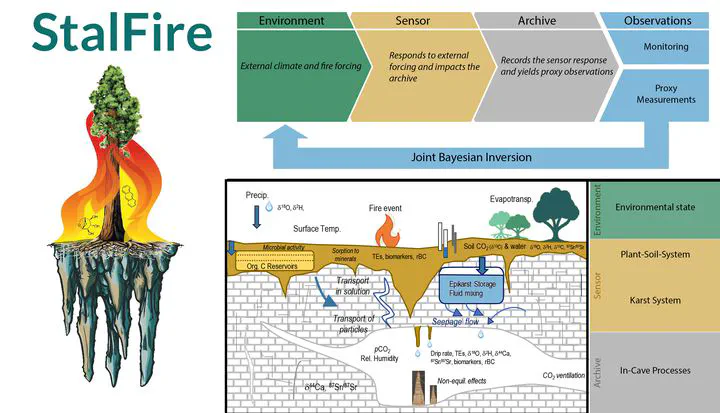StalFire - Hydroclimate-Wildfire relationships in California
 Image credit: StalFire consortium
Image credit: StalFire consortiumExploring the connections between humans, climate, and fire from the past to the present relies on access to high-resolution information about terrestrial climatic conditions and ecosystem changes. Stalagmites are one of the most valuable terrestrial palaeoenvironmental records as they often preserve long climatic sequences with high temporal resolution, can be absolutely dated with high precision, and record detailed information on a range of climatic and environmental variables. For this reason, speleothems are widely used as palaeoenvironmental archives, predominantly to reconstruct past hydroclimate variability. More recently, speleothems have been found to preserve information on past fires via organic molecular biomarkers such as anhydrosugars and polycyclic aromatic hydrocarbons (PAHs) and have become an archive of particular interest for reconstructing joint climate and fire histories beyond the instrumental record.
Despite this promise, palaeoclimate and palaeofire proxy data in stalagmites can be challenging to interpret due to the complex nature of karst systems and speleothem formation that influences climate signal incorporation. A powerful way to improve reconstructions from proxy data are numerical forward models – or “proxy system models” (PSMs) – of the karst and stalagmite system that account for the conditions and processes that govern how external forcings are transmitted through the surface and karst, and ultimately recorded in the stalagmite archive. Here we present a newly developed stalagmite PSM targeting both established palaeoclimate proxies and novel biomarker proxies of fire activity. We will employ the model within a Bayesian joint inversion framework to allow for a robust representation of uncertainties and quantitative integration of multiple proxies.
As part of the StalFire consortium project, the model draws upon extensive monitoring and stalagmite record development in California caves exposed to significant fires. We present forward modelling results of cave hydrology, stable isotope and fire biomarkers using the examples of C67 cave in the southern Sierra Nevada and White Moon Cave in the Santa Cruz Mountains, focusing on disentangling moisture source and precipitation amount effects. Going forward, model inversion will support the exploration of hydroclimate and fire activity in California over the past 70,000 years.
The StalFire project was recently presented as a EGU 2024 meeting poster.